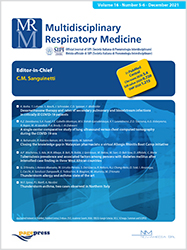The clinical and integrated management of COPD
An official document of AIMAR (Interdisciplinary Association for Research in Lung Disease), AIPO (Italian Association of Hospital Pulmonologists), SIMER (Italian Society of Respiratory Medicine), SIMG (Italian Society of General Medicine)
Keywords:
COPD, Integrated care, ManagementAbstract
COPD is a chronic pathological condition of the respiratory system characterized by persistent and partially reversible airflow obstruction, to which variably contribute remodeling of bronchi (chronic bronchitis), bronchioles (small airway disease) and lung parenchyma (pulmonary emphysema). COPD can cause important systemic effects and be associated with complications and comorbidities. The diagnosis of COPD is based on the presence of respiratory symptoms and/or a history of exposure to risk factors, and the demonstration of airflow obstruction by spirometry. GARD of WHO has defined COPD “a preventable and treatable disease”. The integration among general practitioner, chest physician as well as other specialists, whenever required, assures the best management of the COPD person, when specific targets to be achieved are well defined in a diagnostic and therapeutic route, previously designed and shared with appropriateness. The first-line pharmacologic treatment of COPD is represented by inhaled long-acting bronchodilators. In symptomatic patients, with pre-bronchodilator FEV1 < 60% predicted and ≥ 2 exacerbations/year, ICS may be added to LABA. The use of fixed-dose, single-inhaler combination may improve the adherence to treatment. Long term oxygen therapy (LTOT) is indicated in stable patients, at rest while receiving the best possible treatment, and exhibiting a PaO2 ≤ 55 mmHg (SO2 < 88%) or PaO2 values between 56 and 59 mmHg (SO2 < 89%) associated with pulmonary arterial hypertension, cor pulmonale, or edema of the lower limbs or hematocrit > 55%. Respiratory rehabilitation is addressed to patients with chronic respiratory disease in all stages of severity who report symptoms and limitation of their daily activity. It must be integrated in an individual patient tailored treatment as it improves dyspnea, exercise performance, and quality of life. Acute exacerbation of COPD is a sudden worsening of usual symptoms in a person with COPD, over and beyond normal daily variability that requires treatment modification. The pharmacologic therapy can be applied at home and includes the administration of drugs used during the stable phase by increasing the dose or modifying the route, and adding, whenever required, drugs as antibiotics or systemic corticosteroids. In case of patients who because of COPD severity and/or of exacerbations do not respond promptly to treatment at home hospital admission should be considered. Patients with “severe” or “very severe” COPD who experience exacerbations should be carried out in respiratory unit, based on the severity of acute respiratory failure. An integrated system is required in the community in order to ensure adequate treatments also outside acute care hospital settings and rehabilitation centers. This article is being simultaneously published in Sarcoidosis Vasc Diffuse Lung Dis 2014, 31(Suppl. 1);3-21.
Published
Issue
Section
License
Mattioli 1885 has chosen to apply the Creative Commons Attribution NonCommercial 4.0 International License (CC BY-NC 4.0) to all manuscripts to be published.





